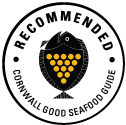

Small scallops with a meaty chunk of muscle in each one with a delicate flavour and texture.
The queen scallops (Mimachalmys varia) that grow on the Falmouth oyster beds are a delicacy that are caught as a by catch of the Fal oyster fishery. A traditional fishery that is restricted to sail and oar power and thus is extremely sustainable. Falmouth Queen scallops have been appreciated by local oystermen for generations but have rarely been sold commercially but in 2017 they began being marketed commercially for the first time. The Fal oyster fishery is well managed and stocks of Queenies are monitored by CIFCA.
They are a different species to the queen scallops caught in other areas of Europe, they are called 'black scallops' by the French as the insides of the shell are a rich dark brown colour.
This is a small fishery and is only carried out in the Fal Estuary. Total landings in 2022 was 65 tonnes (CIFCA report). Queen scallops are mainly exported to France and other EU countries but a domestic market is building.
Updated July 2023

Fal Estuary, Cornwall
Caught by oyster fishermen who use traditional and environmentally friendly methods to fish for oysters using sail and oar power in the Fal Estuary
Learn moreCornwall Good Seafood Guide rates fish on sustainability using a scale of 1 to 5.
1, 2 and 3 are recommended, Fish to avoid are rated 5.
We use the system devised by the Marine Conservation Society (MCS) so our scores are comparable with the scores produced by MCS for the UK and fisheries from all around the world. For more information on scoring click here.
Queen scallops found in the Fal estuary are a rarely fished species called, Mimachlamys varia, the variagated scallop or 'black queen'. which live attached to the seabed by byssus threads similar to those used by mussels to cling on to rocks. They are fast growing and highly abundant animals that are found growing on empty oyster shells on the Fal and Helford oyster beds.
Latest survey of the Fal fishery by Cornwall IFCA shows that queen scallops are still abundant in the Fal esutary although numbers found in the survey decreased in 2023 there are still significant stocks. The report shows an increasing proportion of large scallops on the beds. Stocks natually fluctuate in the area depending on sucess of recruitment. It appears that recruitment has not been as sucessfull in recent years.
The fishery is managed by a local restrictive order that banned the use of engines or winches in the fal oyster fishery in 1868. This has preserved a traditional fishery which is naturally inefficient and thus has sustained this traditional livelihood for 150 years. The fishery is managed by Cornwall Inshore Fisheries and Conservation Authority.
Queen scallops are caught as by-catch in the Truro river oyster fishery which is carried out in the Fal estuary during winter months. Queen scallops are brought up in oyster dredges.






Cornwall Good Seafood Guide is underpinned by the Marine Conservation Society (MCS) Good Fish Guide. The first UK consumer guide to sustainable seafood. For more information visit www.fishonline.org
Cornwall Good Seafood Guide is here to help us all make sustainable seafood choices. Choices that will help us keep the oceans healthy and Cornish fishers' futures safe. This website is funded by Cornwall Wildlife Trust. If you would like to make a meaningful difference to the health of our oceans, please consider making a donation to the Cornwall Wildlife Trust Ocean Emergency fund. Your donation will help safeguard these remarkable environments, ensuring that they continue to thrive for generations to come. Together, we can be stewards of the seas and champions for a healthier, more sustainable future.